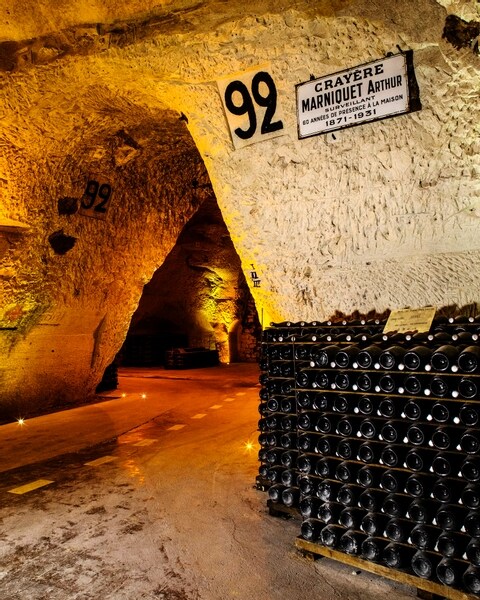Reims
The City
Reims is a city in northeastern France’s Grand Est region. It’s the unofficial capital of the Champagne wine-growing region, and many of the champagne houses headquartered there offer tastings and cellar tours. For more than 1,000 years, French kings were crowned at its Cathédrale Notre-Dame de Reims. This grand cathedral is known for its stained-glass windows and Gothic carved portals, including the Smiling Angel.
Hotels
La Caserne Chanzy
In 1926, the Caserne Chanzy was the first real firehouse in Reims. Its architect, François Maille, was a local who anticipated the Rationalist lines that came into style ten years later. Abandoned in 1993, the building was recently converted into a hotel as part of the American group Marriott’s distinctive Autograph Collection luxury label. Opened in mid 2019, the hotel has the immense advantage of being located in the heart of the city facing the cathedral. The architect Christophe Ballan directed the transformation of the former firehouse into a hotel, retaining its volumes and the special features that were part of its original function, including a brick tower in the courtyard. The Champagne region’s materials, colours, grapevines and graphic symbols inspired Julie Fuillet’s interior decoration. Fuillet created a sophisticated and comfortable contemporary setting devoid of quirks and gimmicks in a sunny palette of colours: honey, absinthe, bronze, yellows and greens. The light fixtures evoke champagne bottles, and the bedding is impeccable.
A Sense of Style
Sease
Sea + ease = Sease. Founded in 1924, the Loro Piana company is now owned by the LVMH Group. The company’s heirs, Franco and Giacomo Loro Piana, are passionate about sailing and skiing, so together they have invented a brand of stylish, high-performance clothes, aimed at sporty types fresh from boating or snowboarding and who want to enjoy après-ski or après-spinnaker time while remaining on-trend. For men only, the clever range of clothes blends merino and cashmere with new high-tech fibres for indoors and out. With just a dozen essential mix-and-match pieces, the collection is available in a limited range of colours. The jackets, sweaters, tracksuits, polo shirts, coats, parkas and windbreakers can all be folded and fitted into a bag made of recycled sailcloth, in which you’ll find, as a charming surprise, the list of regattas in which the sailboat concerned took part. Designed as the perfect after-sport accessory for the man about town, this holdall boasts pure Italian chic and is only available in Milan. Located in the pedestrian area of Brera, the store’s warm, contemporary decor covers two floors and was designed by the interior designer Sebastiano Tosi.
Restaurants
L’assiette Champenoise
One of the outstanding addresses in the region. After a long journey driven by his intense passion for cuisine, chef Arnaud Lallement has settled down at the age of forty-five but has lost none of his ardour. Where in the past he rushed in with over-pronounced accents and hasty risk-taking, now he goes to the heart of his dishes, relieved to have finally snatched up those three stars that were marinating for so many years. As a result, his cooking has become more mineral while still speaking old French, as in the seasonal hare à la royale. Lallement has stopped hunting and become centred, like a ball in the racket’s sweet spot: magnificent langoustines ever so lightly caressed in the pan, delivered almost raw with a reverent touch of lemony oil, and, in an oblique addition, tartare of langoustine pincers in an expressive gelée. The scallops benefit from the same comprehensive, close-up, even intimate approach to the product: the bivalve’s frills come with a parsley emulsion, while a beetroot – civilized at last – yields all its subtle flavours and then some. The elegant contemporary interior has been updated by the Reims architect Grégory Guillemain, with widely spaced tables and perennial names from the world of design (Baccarat, Eileen Gray, Mies van der Rohe, Knoll, Eames, Le Corbusier), a cheeky touch of R’n’B music, artful lighting and a staff who have also relaxed into their stride.
Arts and Culture
Musée de la Reddition
Reims, so badly damaged by the war of 1914-18, is also the city where, on 7 May 1945 at 2:41am, the surrender of Nazi Germany was signed, putting an end to World War II in Europe. Written in English over two pages, the document was signed for the SHAEF (Supreme Headquarters Allied Expeditionary Force) by General Walter B. Smith, General Eisenhower’s chief of staff, by General Jodl for the German High Command, and by General Susloparov for the Soviet High Command. The French general, François Sevez, was present solely as a witness. The act of surrender was definitively ratified, at Stalin’s request, the following day in Berlin. The 7 May surrender declaration was signed in a room of the College Moderne et Technique de Reims.Today, this room has become the Museum of the Surrender. Called the War Room , it is where the surrender took place, in what is now the Lycée Roosevelt, and it the repository of numerous documents.
Download our App to learn more



